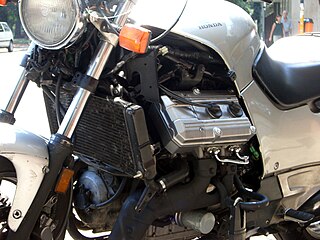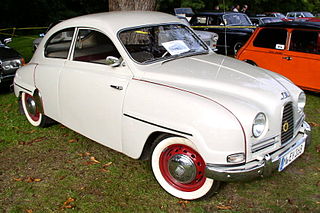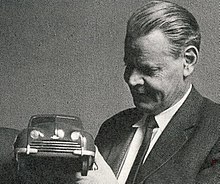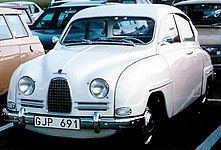
A V4 engine is a four-cylinder piston engine where the cylinders share a common crankshaft and are arranged in a V configuration.

The Saab 9-3 is a compact executive car initially developed and manufactured by the Swedish automaker Saab.

The Saab 99 is a car produced by Swedish manufacturer Saab from 1968 to 1984; their first foray into a larger class than the Saab 96. While considered a large family car in Scandinavia, it was marketed as a niche compact executive car in most other markets. It was manufactured both in Sweden and Finland and was succeeded by the Saab 900, although the 99 continued to be produced alongside its successor. The Saab 90, an updated, less complex version using many 900 parts took over from the 99 in late 1984.

The Saab 93 is the second production automobile that was manufactured by Swedish automaker Saab. Styled by Sixten Sason, it was first presented on December 1, 1955. The 93 was powered by a longitudinally-mounted three-cylinder 748 cc Saab two-stroke engine giving 33 hp (25 kW). The gearbox had three gears, the first unsynchronised. In order to overcome the problems of oil starvation on overrun for the two-stroke engine, a freewheel device was fitted. In 1957, two-point seatbelts were introduced as an option. The 93 was the first Saab to be exported from Sweden, with most exports going to the United States. A Saxomat clutch and a cabrio coach were available as options.

The Saab Sonett is an automobile manufactured by Swedish automaker Saab between 1955 and 1957 and again between 1966 and 1974. Sonetts share engines and other components with Saab 93, 95 and 96 of the same era. It was mainly intended for the lucrative American export market and was only offered intermittently in the Swedish domestic market.
The Saab Toad, or Paddan in Swedish, was a development car Saab Automobile made in 1966 to test out the new chassis, drive train and engine for the Saab 99.

The Saab Catherina is a 1964 prototype automobile, commissioned by the Swedish automaker Saab, designed by Sixten Sason and made at the workshops of the Aktiebolaget Svenska Järnvägsverkstäderna in Katrineholm, Sweden. It is a red, two-seat sports car with a targa top.

Saab Automobile AB was a car manufacturer that was founded in Sweden in 1945 when its parent company, Saab AB, began a project to design a small automobile. The first production model, the Saab 92, was launched in 1949. In 1968 the parent company merged with Scania-Vabis, and ten years later the Saab 900 was launched, in time becoming Saab's best-selling model. In the mid-1980s the new Saab 9000 model also appeared.

The Saab MFI 13 was a February 1965 prototype for the Saab 97 automobile, later known as Sonett II. It was built at the Malmö Flygindustri as they had some experience with plastic manufacturing. The body of the prototype was made of steel though. A second prototype was designed by Sixten Sason and delivered a month later by ASJ in Arlöv.

Ursaab, also known as 92001 and X9248, was the first of four prototype cars made by Saab AB, which at that time was solely an aeroplane manufacturer, leading to production of the first Saab car, the Saab 92 in 1949. The car is now in the Saab Car Museum in Trollhättan. The name "Ursaab" means "original Saab".
Rolf Mellde was an engineer who specialized in performance engines and also a car racing enthusiast.

The Triumph slant-four is an inline four-cylinder petrol car engine developed by the Triumph Motor Company. It first appeared in 1968 in the Saab 99. The first Triumph model to use the engine did not appear until 1972. With an original capacity of 1.7 L, displacement grew over time to 2.0 L. Triumph production ended in 1981.

The Saab B engine is an inline four-cylinder car petrol engine developed by Saab Automobile. A redesign of the Triumph slant-four engine, the B engine displaced 2.0 L and first appeared in 1972. The B engine was used in the Saab 99 and 900 models. Saab began to phase the engine out in 1981.

Automotive design is the process of developing the appearance of motor vehicles, including automobiles, motorcycles, trucks, buses, coaches, and vans.

The Saab 210 is an approximately 70% scale research prototype for the double-delta configuration of the Saab 35 Draken supersonic fighter. It became known by the unofficial nickname Lilldraken. Its first flight was on 21 January 1952.

The Saab two-stroke was a two-stroke cycle, inline, two cylinder, and later three cylinder engine manufactured by Swedish automotive manufacturer Saab that was based on a design by German manufacturer DKW.
Björn Erik Anders Envall, is a Swedish retired automobile designer. He was head of the design department at Saab.

Trollhättan Assembly is an automobile factory in Trollhättan, Sweden. The factory opened in 1947 under the ownership of Saab AB, then passing to Saab Automobile. From 1989 to 2010, the factory was partially (1989–1999), then completely (2000–2010) owned by General Motors. In 2010, Saab was sold to Spyker Cars. The plant ended production in 2011 and restarted in 2013, after the NEVS purchase of Saab Automobile. The Trollhättan complex, including the assembly, is now the sole site of all Saab engineering and manufacturing activities. After NEVS announced its closure in March 2023, the factory was sold to Stenhaga Invest AB, with both Polestar and EV Electra showing interest in buying the factory.

Husqvarna Motorcycles GmbH is an Austrian company which designs, engineers, manufactures and distributes motocross, enduro, supermoto and street motorcycles.

The Saab Car Museum is an automobile museum in Trollhättan, Sweden. It covers the history of the Saab brand of automobiles manufactured by Saab under various owners since 1947.
























